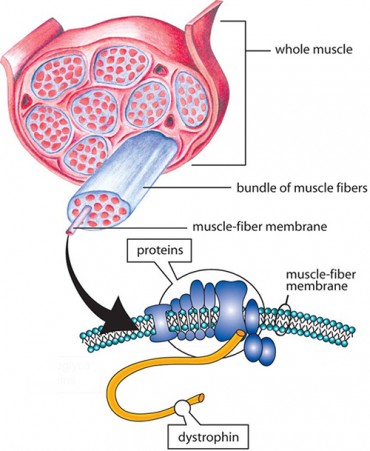January 3, 2016 – Genomics tool, CRISPR is altering the way we fight heritable diseases. The acronym stands for clustered, regularly interspaced short palindromic repeats. I first wrote about this tool back in December 2013. It is proving to be a technology with ramfications for repairing defective genes whether to cure disease in humans or to improve the food we grow.
The latest news concerns using CRISPR to treat Duchenne Muscular Dystrophy (DMD). DMD is a disease I have personally witnessed as a young man. I remember a nearby neighbour with a DMD child. Confined to a wheelchair and eventually requiring a respirator to breathe, his plight has remained a vivid and disturbing childhood memory. I remember the day the telephone rang with Barry’s mom telling mine that her son had died.
DMD is a heritable disease that affects boys. They seldom live beyond their mid-20s. Its cause is a defective dystrophin gene that leads to a missing essential protein needed for normal development and maintenance of musculoskeletal tissue.
Past attempts to treat DMD patients by reintroducing the dystrophin protein using a virus agent have proven to be a very difficult. The gene is too large to use viruses as a carrier. Therapies have tried to create a micro encapsulated version of the gene but this technique has yielded only modest improvements in clinical trials.
CRISPR, however, is proving to be an improvement on any other technological fix. Using it researchers are experimenting with ways to manipulate DNA sequences by inserting a repaired dystrophin gene into diseased tissue. Teams at Duke University in North Carolina, and Harvard in Massachusetts have demonstrated the efficacy of this approach treating DMD mice using CRISPR and its Cas9 sub-tool.
Using viruses to carry the new genetic instructions, repaired dystrophin was injected into the bloodstream, muscles and skeletal tissue of test subjects. The mice achieved significant musculoskeletal improvements although not within the fully normal range of capability within four weeks after treatment. Not yet a DMD cure, CRISPR technology, however, is demonstrating significant potential in tackling heritable diseases producing far better outcomes.
The research results appear in two published reports in the journal Science posted on December 31, 2015. One is entitled In vivo genome editing improves muscle function in a mouse model of Duchenne muscular dystrophy while the second is Postnatal genome editing partially restores dystrophin expression in a mouse model of muscular dystrophy.

















[…] genome editing partially restores dystrophin expression in a mouse model of muscular dystrophy. [1] Nelson CE, Hakim CK, Ousterout DG, et al. in vivo genome editing improves muscle function in a […]